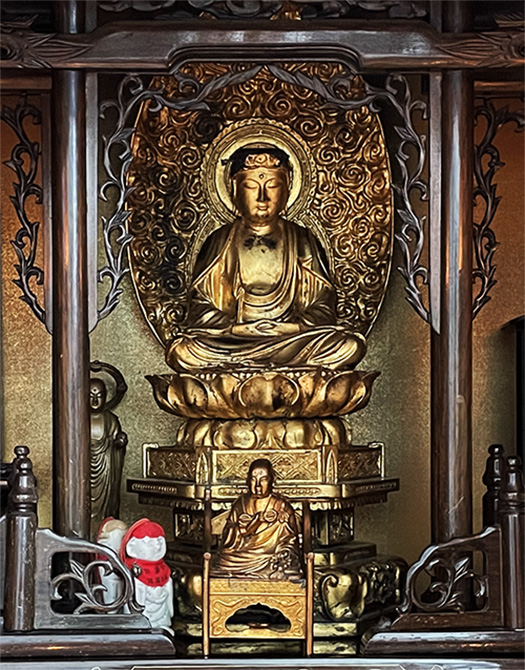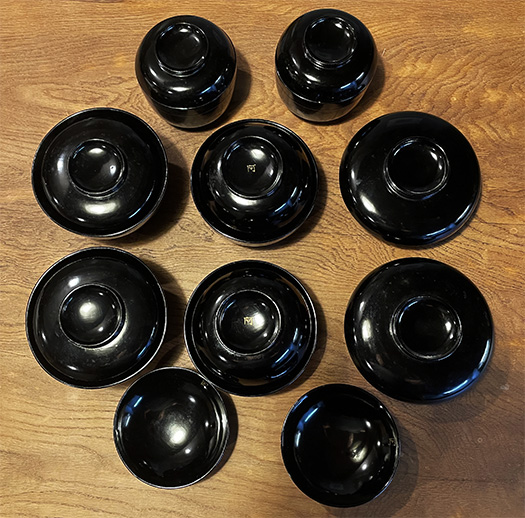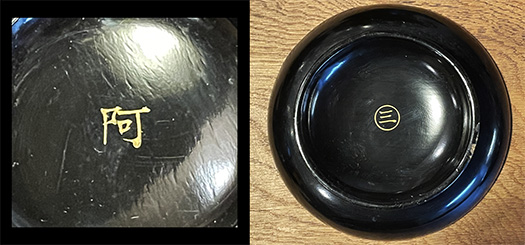
連載で旧岩崎邸探訪記を続けているなかですが、本日は閑話休題であります。
きのうは9月9日重陽。父の祥月命日でして長兄の実家にて参拝。残念ながらお坊さんが例の流行病に罹患されたということで、ひさしぶりに兄弟だけで近況報告会。
なんですが、そういうことだったので久しぶりに実家の仏壇と正面から向かい合って、きれいなお顔のお仏像とじっくり対面させていただいていました。幼少期からずっと見ていたはずの仏像ですが、お経を小声で上げさせていただきながら、拝顔。
わが家は1905年(明治38年)、いまから118年前に北海道に渡って来ている。それまで広島県福山市近郊・今津の地で営んでいた商家の経営が幕末から明治の時期に傾いて、その挽回のために当主であった祖父が一念奮起して北海道移住を決意した。
この仏壇・仏像は「仏壇背負って」という本家意識をあらわす言葉が残っているように、祖父の家系への使命感そのものとして北海道に渡ってきたと伝えられる。祖父としては北海道の地で衰退した家運を盛り上げたいという希望を持っていたに違いないので、この仏像も「本家」の証として、来道したに違いない。少なくとも118年前からはわが家にあり続けている。ご本尊仏像は、なかなかに美麗。
下に小さい像があるけれど、これは真言の開祖、空海さんの仏像だと聞かされている。たぶん、江戸期のご先祖の祖母が四国八十八箇所巡礼したといわれ、記念に入手したものだろうか。
わたしは末っ子なのでこういった「家意識」はそう濃厚ではないけれど、加齢とともにご先祖様の思念と徐々に親しさの念が強まってくる。南無大師遍昭金剛・・・。


また、きのうは兄からこんな「塗り物」を受け取った。漆塗りの食器。
「阿」と「三」の文字が金字で屋号として描かれている。伝承では、家系は江戸期に「あがや・三木家」として商家を営んでいて、その時期に一種の「贈答品」として作らせたものだと言われている。
あがや、というのは兵庫県姫路市の「英賀保」の「あが」とされて、戦国期の秀吉に攻められ落城した「英賀城」なのだと伝わっている。落城後、三木の一族は各地に分散し、そのうちの一統が瀬戸内の商都・尾道で商家になって名乗ったという家系伝承。
兄も高齢になったので、お裾分けとして弟たちにということなのか。
ほかの話題に終始していたので、この分配についてきちんとした話は聞いていなかった。お坊さんが不在だったので、つい話すきっかけを失ったのかも知れない(笑)。
こういった漆塗りの食器を使っての格式的な会合とか、食事会とかとは無縁で人生を過ごしてきたので、まことに「猫に小判」のような気持ちでありますが、ありがたく受け取ってきた次第。
ちょっとご先祖さまたちと近づいたような気分で、神妙にしております・・・。
English version⬇
At my parents’ house on the anniversary of my father’s death, a Buddha image and a traditional artifact.
The soft expression on the face of the main Buddha image conveys the feelings that my grandfather and father held so dear to their hearts. As the youngest child, I was forced to talk with myself, who had lived a life of wild abandon. The statue is a symbol of the Buddha’s life as the youngest child.
In the midst of my continuing series of articles on the former Iwasaki Residence, I would like to take a break today.
Yesterday was Chou-you, September 9. It was the anniversary of my father’s death, and I paid my respects at my eldest brother’s parents’ house. Unfortunately, the monk had contracted an epidemic disease, so for the first time in a while, we had a status report meeting with just my siblings.
I was facing my parents’ Buddhist altar for the first time in a long while, and I had a good look at the Buddha statue with a beautiful face. I must have been looking at this Buddha image since I was a child, but I was allowed to whisper sutras while I worshipped the face.
My family came to Hokkaido in 1905, 118 years ago now. My grandfather, who was the head of the family, decided to move to Hokkaido to recover from the financial difficulties of his family’s business in Imazu, a suburb of Fukuyama City, Hiroshima Prefecture, during the late Edo and Meiji periods.
As the phrase “carrying the altar on his back,” which expresses the family’s awareness of its importance to the family, remains, it is said that this Buddhist altar and statue came to Hokkaido as a part of the grandfather’s sense of mission to the family. My grandfather must have hoped to revitalize his family’s declining fortunes in Hokkaido, and this Buddha image must have come to Hokkaido as a sign of his “head family. It has been in our house for at least 118 years. The main Buddha image is quite beautiful.
There is a smaller statue below, which I am told is of Kukai, the founder of the Shingon sect of Buddhism. It is said that the grandmother of one of my ancestors in the Edo period made a pilgrimage to 88 temples in Shikoku and probably acquired this statue as a commemorative gift.
I am the youngest child in the family, so I do not have a strong sense of “family” as such, but as I get older, I gradually feel more and more close to the memory of my ancestors. Namu Daishi Hensho Kongo…
Also, yesterday I received this “lacquered” item from my brother. Lacquered tableware.
The characters “a” and “three” are painted in gold letters as a store name. According to tradition, the family was a merchant family during the Edo period (1603-1868), and the tableware was made as a kind of “gift” during that period.
Agaya” is said to be the “Aga” of “Egaho” in Himeji City, Hyogo Prefecture, and is believed to be the name of “Ega Castle,” which was attacked by Hideyoshi in the Warring States period and fell. After the castle fell, the Miki family dispersed to various places, and one of the families became a merchant family in Onomichi, a commercial city in the Seto Inland Sea, and took the name of the family tradition.
The older brother is now old, so he has decided to pass the family legacy on to his younger siblings.
Since I was occupied with other topics, I did not hear a proper story about this distribution. The monk was away, so I may have lost the chance to talk about it (laugh).
Since I have spent my life without having any formal meetings or dinners using such lacquered tableware, I felt like a “cat with a pair of koban,” but I was grateful to receive it.
I feel as if I have become a little closer to my ancestors.
Posted on 9月 10th, 2023 by 三木 奎吾
Filed under: 未分類







コメントを投稿
「※誹謗中傷や、悪意のある書き込み、営利目的などのコメントを防ぐために、投稿された全てのコメントは一時的に保留されますのでご了承ください。」
You must be logged in to post a comment.